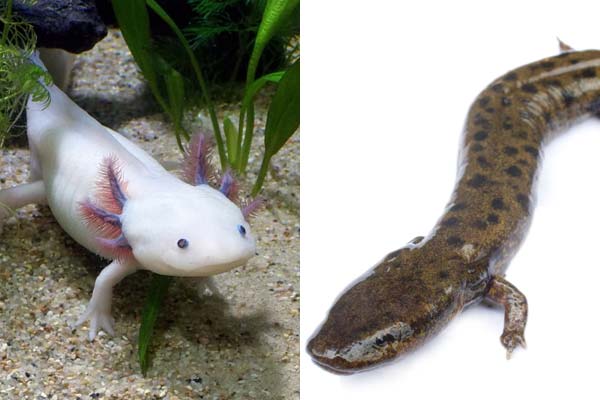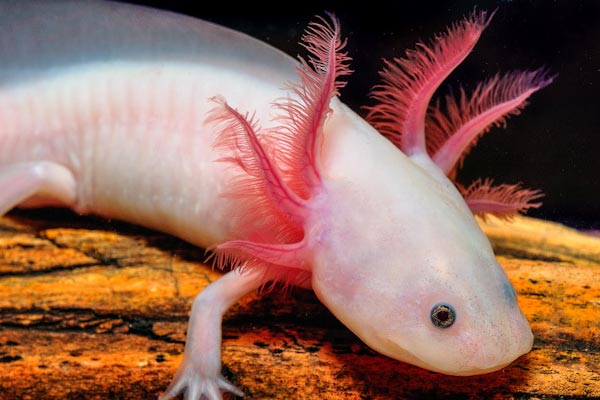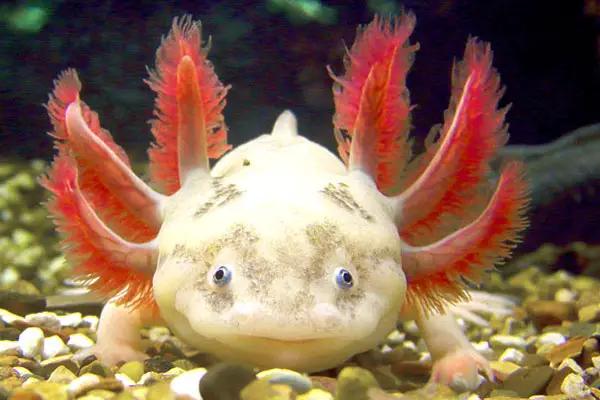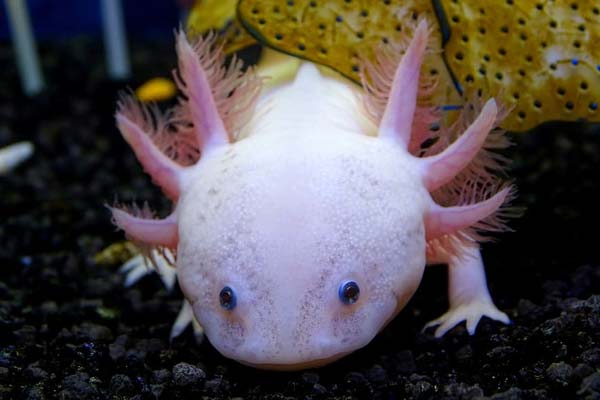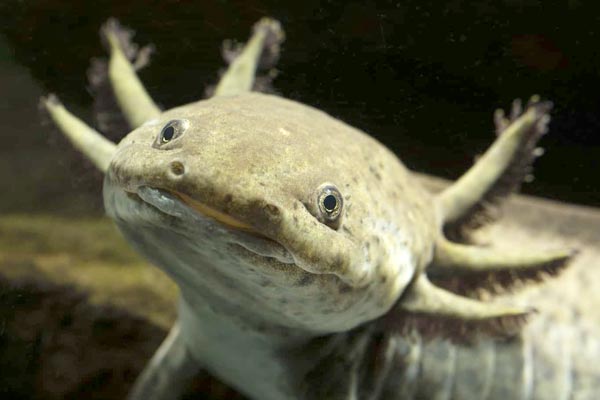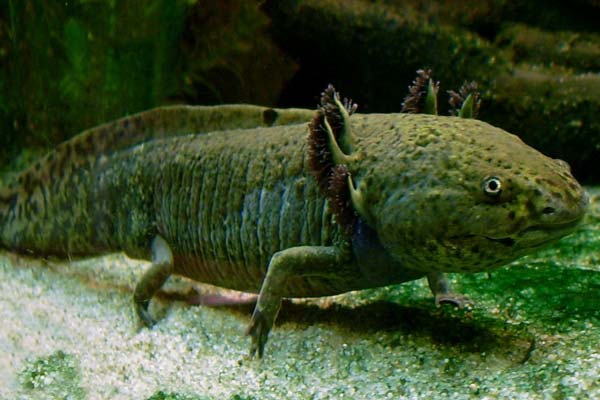Axolotl vs. Mudpuppy: What Makes These Salamanders So Different?
Axolotls and mudpuppies are two aquatic salamanders with similarities and striking differences. Both are members of the order Urodela, which includes all salamanders but belong to different families. Axolotls are classified under the Ambystomatidae family, while mudpuppies belong to the Proteidae family.
One of the most notable differences between axolotls and mudpuppies is their appearance. Axolotls have a unique appearance, with external gills and a long, slender body. They also have various color variations, including pink, gold, and grey.
Mudpuppies, on the other hand, have a stocky body with short legs and a flattened head. They are usually dark brown or grey and have small, barely visible gills.
Another significant difference between axolotls and mudpuppies is their habitat. Axolotls are native to Lake Xochimilco in Mexico and are found in some rivers and streams.
Mudpuppies, on the other hand, are found in lakes and rivers throughout North America. Despite their different habitats, salamanders require clean water and good-quality oxygen levels to survive.
Mudpuppy Vs. Axolotl: How Are These Salamanders Different?
Mudpuppies and Axolotls are both fully aquatic salamanders, but they are classified as different species from different families due to their strikingly different characteristics. This section will highlight the differences between these two salamanders.
What Is A Mudpuppy?
Mudpuppies are giant salamanders that are native to North America. They have slimy, dark brown or black skin with a yellowish underbelly. They are also called “waterdogs” because they resemble ordinary mudpuppies. These creatures have the potential to reach a maximum length of 13 inches and can sustain a lifespan of up to 20 years.
What Is An Axolotl?
Axolotls are neotenic salamanders that are native to Mexico. They have a unique appearance, with external gills protruding from their heads. They come in various colors, including black, brown, and white. These creatures can grow up to 18 inches long and live up to 15 years.
Mudpuppy and Axolotl Similarities
Although Mudpuppies and Axolotls are different species, they do share some similarities. Both salamanders are fully aquatic and use external gills to breathe underwater. They also have a similar diet, consisting of small fish, insects, and crustaceans.
However, there are also significant differences between the two species. Mudpuppies have a narrow head that fits with their slim body, while Axolotls have wider heads. Mudpuppies also have a more elongated body, while Axolotls have a more rounded body shape.
Additionally, Mudpuppies have four toes on their front legs and five on their back legs, while Axolotls have five on their front and back legs.
Key Differences Between Axolotls And Mudpuppies
Axolotls and mudpuppies are fully aquatic salamanders but differ in various ways. Here are some key differences between the two species:
Size
Axolotls and mudpuppies differ significantly in size. On average, mudpuppies are longer, ranging between 13 and 17 inches, while axolotls typically grow to 6-9 inches. However, larger axolotls, up to 18 inches, have been reported.
Body Dimensions
Regarding body dimensions, axolotls and mudpuppies have contrasting shapes and proportions. Mudpuppies have a slim body with a narrow heads, while axolotls have a wider head. Both species have external gills protruding out the side of their heads.
Lifespan
Mudpuppies tend to live longer than axolotls. On average, mudpuppies can live up to 20 years, while axolotls have a lifespan of around 10-15 years.
Coloring and Patterns
Axolotls and mudpuppies also differ in their coloration and patterns. Mudpuppies have a dark brown or black body with light spots, while axolotls can come in various colors, including black, white, gold, and shades of brown. Axolotls can also exhibit various patterns, such as speckles or stripes.
Mudpuppy Vs. Axolotl Ownership
When it comes to owning an axolotl or mudpuppy, there are a few things to consider. This section will explore the differences between the two species regarding availability, care, and ease of breeding.
Availability
Axolotls are more commonly found as pets compared to mudpuppies. You can easily find axolotls in pet stores and online, whereas mudpuppies are not as commonly available in the pet trade. However, both species can be obtained from breeders.
Care
Axolotls and mudpuppies have different care requirements in captivity. Axolotls are aquatic and require a tank with plenty of water, while mudpuppies are semi-aquatic and need both water and land areas in their enclosure. Axolotls prefer cooler water temperatures, while mudpuppies require warmer temperatures.
Both species have specific dietary requirements that consist of a diverse range of live or frozen foods, such as worms, shrimp, and fish. Axolotls are more sensitive to the quality of water they inhabit and need regular water changes and filtration to maintain optimal conditions. On the other hand, mudpuppies are more resilient and can tolerate poorer water conditions with relative ease.
Easier To Breed
Breeding axolotls is generally easier than breeding mudpuppies. Axolotls can reproduce in captivity without hibernation, while mudpuppies require a cooling period to induce breeding. Axolotls also lay more eggs than mudpuppies, making them more prolific breeders.
Can You Keep A Mudpuppy And Axolotl Together?
Assessing the compatibility of keeping mudpuppies and axolotls in the same habitat is crucial before deciding to keep them together. While both are aquatic amphibians, they have different needs and behaviors that can affect their cohabitation.
First, it is essential to note that mudpuppies and axolotls belong to different genera, with mudpuppies belonging to the Necturus genus and axolotls to the Ambystoma genus. Although they share some similarities, such as their neotenic characteristics, they also have distinct physical appearance and behavior differences.
One significant factor to consider is the size of the aquarium or tank. Mudpuppies can grow up to 13 inches long, while axolotls can reach 18 inches. Therefore, they require a spacious habitat to accommodate their size and swimming needs. Experts recommend a minimum of 20-gallon tanks for each amphibian.
Another factor to consider is their feeding habits. Mudpuppies are carnivorous and prefer live food, such as worms, snails, and small fish. On the other hand, axolotls are also carnivorous but can eat frozen or pelleted food. Feeding them together can be challenging, as mudpuppies might outcompete axolotls for food.
Moreover, mudpuppies are more aggressive than axolotls and might bully or attack their tank mates. This behavior can cause stress and injuries to axolotls, leading to health problems.
Water Dogs Vs. Axolotls Vs. Water Puppies: Physical Characteristics
When comparing Water Dogs, Axolotls, and Water Puppies, their physical characteristics are some of the most notable differences.
Characteristics Of Adult Salamanders
Adult salamanders, including Water Dogs and Axolotls, are known for their elongated bodies, short legs, and long tails. They have smooth, moist skin, often covered in mucus to keep them hydrated. Both species also have external gills that allow them to breathe underwater.
Examining the Physical Attributes of Water Dogs, Axolotls, and Water Puppies
Water Dogs, also known as mudpuppies, are typically larger than Axolotls and can grow up to 18 inches. They have a broad, flat head, wide mouth, and sharp teeth. Their skin can range from brown to black, and they have tiny, stubby legs that are not very strong.
Conversely, Axolotls are smaller than Water Dogs and typically only grow up to 9 inches long. They have a round head, small eyes, and a wide, toothless mouth. Their skin can range from pink to black, and they have four thin, delicate legs used for swimming.
Water Puppies, or the larval form of Water Dogs, look quite different from their adult counterparts. They have long, slender bodies with feathery external gills and flat tails. Their skin is usually lighter than adult Water Dogs and Axolotls, and they have tiny, underdeveloped legs.
Why Do Axolotls And Mudpuppies Stop Growing?
Axolotls and mudpuppies are salamanders that exhibit neoteny, meaning they retain their juvenile features into adulthood. This phenomenon is due to their ability to regenerate lost body parts, including limbs, spinal cord, heart, and even parts of their brain. However, neoteny comes at a cost, affecting their growth patterns and physiology.
Exploring the factors influencing the growth patterns of axolotls and mudpuppies
Several factors influence the growth patterns of axolotls and mudpuppies. These include:
- Habitat: Axolotls and mudpuppies are aquatic salamanders that require specific water conditions to thrive. Water temperature, quality, and availability changes can affect their growth and development. For instance, axolotls prefer cooler water temperatures between 16-18°C, while mudpuppies can tolerate slightly warmer water up to 24°C.
- Nutrition: The diet of axolotls and mudpuppies is crucial to their growth and overall health. These salamanders are carnivorous and feed on small prey, including insects, worms, snails, and fish. A lack of proper nutrients or an imbalanced diet can stunt their growth and lead to health problems.
- Genetics: The genetics of axolotls and mudpuppies play a significant role in their growth patterns. Different species and subspecies exhibit varying growth rates and sizes. For instance, the tiger salamander, a close relative of the mudpuppy, can grow up to 14 inches, while mudpuppies typically reach 8-13 inches long.
- Age: Age is another crucial factor that influences the growth patterns of axolotls and mudpuppies. These salamanders reach sexual maturity at around 18-24 months, after which their growth rate slows significantly. However, they can continue to grow throughout their lifespan, albeit slower.
Conclusion
Axolotls and Mudpuppies are distinct salamander species with notable differences. Axolotls possess regenerative abilities, have a wider head and shorter body (maximum size of 9 inches), and are found in Mexico City’s canals and lakes.
In contrast, Mudpuppies are larger (13-17 inches), have a narrower head and slim body, and inhabit freshwater habitats in North America.
Both species require a diet of live or frozen food like bloodworms, earthworms, and brine shrimp. Care involves maintaining suitable aquarium conditions with clean, well-oxygenated water and hiding places.

